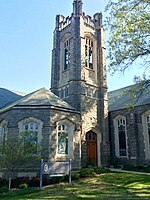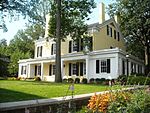Princeton University Library
Historic district contributing properties in Mercer County, New JerseyLibraries in New JerseyPrinceton University buildingsUniversity and college academic libraries in the United StatesWikipedia page with obscure subdivision

Princeton University Library is the main library system of Princeton University. With holdings of more than 7 million books, 6 million microforms, and 48,000 linear feet of manuscripts, it is among the largest libraries in the world by number of volumes. The main headquarters of the university system is the Harvey S. Firestone Memorial Library building, named after tire magnate Harvey Firestone. Additionally, Princeton is part of the Research Collections and Preservation Consortium (ReCAP) along with Columbia Libraries, Harvard Library and New York Public Library.
Excerpt from the Wikipedia article Princeton University Library (License: CC BY-SA 3.0, Authors, Images).Princeton University Library
Washington Road,
Geographical coordinates (GPS) Address Nearby Places Show on map
Geographical coordinates (GPS)
| Latitude | Longitude |
|---|---|
| N 40.349416666667 ° | E -74.657472222222 ° |
Address
Firestone Library
Washington Road 1
08544
New Jersey, United States
Open on Google Maps









